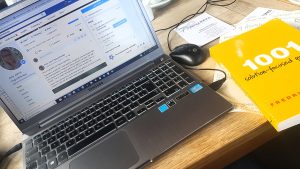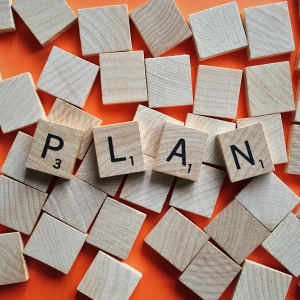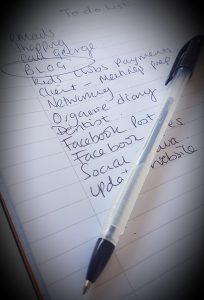Unlearning the art of Procrastination…. Part 2, How can we do it better?
 In Part 1, I talked about how although our Future Self can see the benefit of long- term goals, it’s our Present Self that must act, and this part of the brain can be selfish, and only think of the here and now. I mentioned the difference between an active procrastinator and the benefits of being one and how we can go from this, to becoming a passive procrastinator and stop getting things that are important to us done!
In Part 1, I talked about how although our Future Self can see the benefit of long- term goals, it’s our Present Self that must act, and this part of the brain can be selfish, and only think of the here and now. I mentioned the difference between an active procrastinator and the benefits of being one and how we can go from this, to becoming a passive procrastinator and stop getting things that are important to us done!
So, where do we start dealing with passive procrastination?
Well we know that we must take the pressure off, so we need to stop the negative internal talk. If we focus on everything we are not doing, we will get stuck in that vicious circle and add more stress and anxiety to the situation, so we need to be calm, relaxed and in control of what we do and when we do it.
Don’t get lost in the feeling, I will feel better when I have done it, or I need to do this before I can really do that. Feelings do not mean you will do it.
It’s as simple as get on with it, make a start even if it’s a small one. Don’t listen to the internal voice!
Break it down in to small achievable actions. When we do this, the brain will see it as a challenge stress rather than a threat stress. Therefore, the brain will realise just enough cortisol to give us Adrenalin to achieve the goal.
Threat stress leads to overwhelm
If we see something as a threat stress, that’ when we feel overwhelmed. The brain will see it as we are going to die, so we may as well pump the system with all our cortisol and that’s when we end up, unable to think clearly, organise our self or react. Our flight, fight or freeze response kicks in.
We run away (do something else), get frustrated, angry either at ourselves (or others potentially) or we just do nothing, we may watch TV or surf the internet, get lost in social media! Sound familiar?
Actions to take to manage Passive procrastination
So possibly the first action is to spend time doing an action plan of what steps/actions you need to do. Look at when and where you will do them, what can you do to make sure you achieve that first action. When I was doing my portfolio for my qualification, I felt overwhelmed by the amount and some of the questions. I put it off, but I needed to get it done! So, I set up my laptop the night before, I chose one question that I was going to work on and got everything I needed, for the morning. In my experience getting up and getting on with something is the best thing for me, otherwise I get distracted very easily.
Make a deal with yourself or use the I will just do – by keeping the initial action brief. The idea is to make it as easy as possible to get started and then trust that your momentum will carry you forward. What we normally find is that we keep going once we have started. For example, I have not felt like going running, but I said its ok I will do 10 minutes and 10 minutes back then I can chill out afterwards, by the end of the run I had done 6K.
Basically, if I treat my primitive brain like I treat my 8-year son, it works. He may not want to go swimming on a Friday night after school, I can completely understand I do not want to go either if I  an honest, being fully clothed poolside is so hot and by the end of it I am normally melting, not pleasant and even worse at the end of the week! But that is when his lesson is. I know that if I can get him into the pool, he will just get on with it.
an honest, being fully clothed poolside is so hot and by the end of it I am normally melting, not pleasant and even worse at the end of the week! But that is when his lesson is. I know that if I can get him into the pool, he will just get on with it.
So, I work on the basis of, just do 2 lengths for me and then you can get out, Just jump in the pool and see if you can get me wet. I am pretty sure he is not stupid, and he knows what I am doing, but it works and every time. Don’t get me wrong we still have our disagreements on occasion, but if I keep calm and relaxed and just stick to my plan, we are fine.
It is about not listening to the primitive brain telling you do just do this. As NIKE says, “Just Do IT”. ™
Try the Pomodoro Technique!
One technique that I use and have taught many clients is the Pomodoro Technique. A simple but effective technique I use all the time.
1. Set a timer for 25 minutes.
2. In that 25 minutes you will focus solely on the task at hand using the example above, my 1st question for my portfolio.
3. At the end of the 25 minutes, I set it for 5 minutes and go and do something else.
4. Make a cup of tea, hangout the washing. At the end of 5 minutes I reset the timer for 25 minutes.
How quickly will you have done a couple of hours of work on the thing you want to, without realising. What have we done? We have broken time down in to small achievable chunks. Small measures of progress help to maintain momentum over the long-run, which means you’re more likely to finish large tasks. The faster you complete a productive task, the more quickly your day develops an attitude of productivity and effectiveness.
Temptation Bundling
OR you could try Temptation Bundling – this is a concept that came out of behavioural economics research performed by Katy Milkman at The University of Pennsylvania. This strategy suggests that you bundle a behaviour that is good for you in the long-run with a behaviour that feels good in the short-run. Keeping both future self and present self-happy!
For example, only listen to audiobooks or podcasts you love while exercising. Only get a pedicure while processing overdue work emails. Only watch your favourite show while ironing or doing household chores. For me I love to socialise, so going for a run while I spend time with people. What would your bundles look like for you?
Accountability
Or how about you make the consequences of procrastination more immediate? So, when I lived in Bristol, I use to go swimming in the evening. It was hard to get up off the sofa once I sat down. But I would arrange to go with a friend and pick her up. If I didn’t show up, I would let her down.
 Or a more recent example is my working buddy – Kim Willis from @SaveYourTimeBusinessSupport We meet at a coffee shop and sit together but we then work on our own things. Don’t get me wrong we have a little chat and a giggle, but we do focus on our task in hand. And it works. It would be very rude of me to disturb Kim with just general chit chat, and not very fair on her. So, I work more efficiently in this time.
Or a more recent example is my working buddy – Kim Willis from @SaveYourTimeBusinessSupport We meet at a coffee shop and sit together but we then work on our own things. Don’t get me wrong we have a little chat and a giggle, but we do focus on our task in hand. And it works. It would be very rude of me to disturb Kim with just general chit chat, and not very fair on her. So, I work more efficiently in this time.
Plan your Future Actions
Plan your future actions and have strategies that help you achieve what you want to. For example, plan your meals and buy only what you need. Make meals up before you need them. If you get lost in social media delete the apps when you should be working. You can reduce the likelihood of mindless channel surfing by hiding your TV in a closet or removing from the bedroom if you are looking to improve sleep. You can build an emergency fund by setting up an automatic transfer of funds to your savings account. These are all examples of commitment devices that help reduce the odds of procrastination.
Keeping the momentum going and learning to ignore the procrastinating primitive brain
In the past in my old job when I was in complete overwhelm and working in my primitive brain and not knowing where to start, I’d write a list; in fact I write lists of lists. I have been known to write on napkins I have got from coffee shops. The aim was to empty my brain so as not to forget things, but then I would just jump from one thing to another. I can remember leading up to Christmas, I had ‘paint the hall walls’ on the list!! Really was this a priority before Christmas? Was it realistically going to get done? So, what can we do to make sure we are focused on the most important things the next day? We can shorten that list. TAKE decorating off the list. We knew it had to be done, we weren’t going to forget, but at that time it was not important.
The five most important things
A top tip is that at the end of each work day, write down the five most important things you need to accomplish tomorrow (do not go over.) Then you need to prioritize those tasks in order of their true importance. This means that tomorrow you will start on the most important as you will already have planned the night before and got everything ready. When you start in the morning, you do not do anything else until you finish. Work offline if possible so not distracted by incoming email or messages. You could use the Pomodoro technique. At the end of the day, your final task is to start a new list, any unfinished tasks get moved to the next list. You may find that emergencies pop up and you must change priorities and that is fine, but this is where you must understand if it genuine or is it my present self, self- sabotaging.
Think which brain are you working in? By doing so you help yourself to ignore distractions as much as possible. The other thing it will do though is to help you figure out the priorities. If it keeps getting moved to the next day list, is it important? Go back to being an active procrastinator, take time to notice which ones you are moving. Do they not seem that important anymore? I.e., we had started the decorating of our hallway, but a busy lifestyle meant we had not had time to finish it. My son’s birthday and Christmas outweighed the decorating in December, so it had to wait. It would get done when it got done! By using this technique, we are also lessening multitasking, something that as I have mentioned before we are not that good at.
Multi-tasking
 We may like to think we are good at multi-tasking, and the speed the brain can prioritise and reprioritise is so incredible, that we think we can. However, the brain isn’t very good at doing more than one thing at a time. So, by taking that away by focusing on one thing, we improve our ability to think, the work we do is of a better quality, we become great at that one task rather than semi-great at lots of tasks.
We may like to think we are good at multi-tasking, and the speed the brain can prioritise and reprioritise is so incredible, that we think we can. However, the brain isn’t very good at doing more than one thing at a time. So, by taking that away by focusing on one thing, we improve our ability to think, the work we do is of a better quality, we become great at that one task rather than semi-great at lots of tasks.
Try visual cues
I also use visual cues to help me achieve my goal. Strava, for my exercise, I love to see how many KM’s I have run over the month, it makes me feel great. Although we need to be careful that if we are overly stressed, we will be working in our primitive brain and therefore run the risk of beating ourselves up if we do not see improvements. I think the biggest tip I can give is when you notice that you are doing that is to take a step back and stop for a moment. Ask if you like how you feel and if not, what you need to do, to feel different. We are back to looking at the small achievable actions. We can get momentum again and move on.
So, to finish up, in short, a Passive procrastinator procrastinates in the traditional sense that we all think they do. They are paralyzed by their indecision to act and fail to complete task. In contrast, Active procrastinators are a “positive” type of procrastinator. They prefer to work under pressure, and they make deliberate decisions to procrastinate. You can choose which one you want to be by putting simple strategies that work for you in place. Remember, to keep relaxed and calm and don’t beat yourself up if you are not perfect.
Whatever it is you are procrastinating on if you need help to get started you can contact me:
Call me: 07801481724
Email me: Amy@AmyJohnsHypnotherapy.co.uk
Message me on Facebook Page www.facebook.com/AmyJohnsHypnotherapy
or via my Website www.amyjohnshypnotherapy.co.uk/contact
Oh, and by the way…. just to confirm I did book that trek, when I realised what I was doing, I just stopped and booked it. Now I have done that I know that everything that I will need to do from training to booking accommodation will happen. I have no choice, I trust myself that I will do it when the time is right. xxx

Leave a Reply